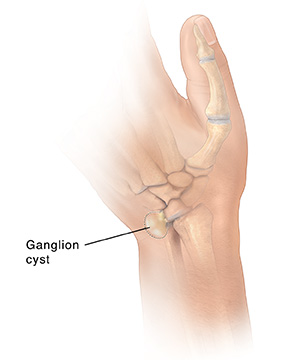Ganglion Cyst: Hand
A ganglion cyst is a firm, fluid-filled lump that can suddenly appear on the front or back of the wrist or at the base of a finger. They are the most common type of mass or lump on the hand. These cysts grow from normal tissue in the wrist and fingers. They range in size from a pea to a peach pit. Ganglion cysts are common. But they don’t spread, and they don’t become cancer. They can occur after an injury. But many times it isn’t known why they grow. Ganglion cysts can change in size, and may go away on their own.

What are the symptoms of a ganglion cyst?
A ganglion cyst is sometimes painful, especially when it first occurs. Constantly using your hand or wrist can make the cyst enlarge and hurt more. Some hand and wrist movements, such as grasping things, may also be difficult.
How does a ganglion cyst develop?
Your wrist and hand are made up of many small bones that meet at joints. Tendons attach muscles to the bones at the joints. The tendons allow the joints to bend and straighten. Both tendons and joints are lined with tissue called synovium. This tissue makes a thick fluid that keeps the joints and tendons moving easily. Sometimes the tissue balloons out from the joint or tendons and forms a cyst. As the cyst fills with fluid and grows, it appears as a lump you can feel.
Where do ganglion cysts occur?
A ganglion cyst can occur anywhere on the hand near a joint. Cysts most commonly appear on the back or palm side of the wrist, or on the palm at the base of a finger. Your healthcare provider can usually diagnose a cyst by examining the lump. They may draw off a little fluid and order an X-ray to rule out other problems.
How is a ganglion cyst treated?
Your healthcare provider may just watch your ganglion cyst. Many shrink and become painless without treatment. Some go away altogether. If the cyst is unsightly or painful, or makes it hard for you to use your hand, your healthcare provider can treat it. Or, if needed, it may be removed surgically.
Nonsurgical treatment
To shrink the cyst, your provider may remove (aspirate) the fluid with a needle. If the cyst hurts, your provider may also give you an injection of an anti-inflammatory medicine, such as cortisone, to ease the irritation. Your hand may then be wrapped to help keep the cyst from recurring.
Surgery
If the cyst comes back after treatment, your surgeon may remove it surgically. A part of the tissue that lines the joint or tendon is removed along with the cyst. This helps prevent another cyst from forming. But it's still possible for the cyst to come back after surgery. Usually, only your hand or arm is numbed, and you can go home a few hours after surgery. Your hand may be in a splint for several days. You can usually go back to your normal activities 2 to 4 weeks after surgery.